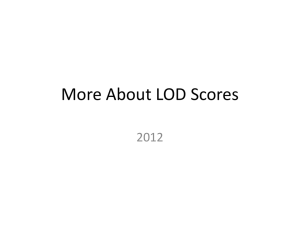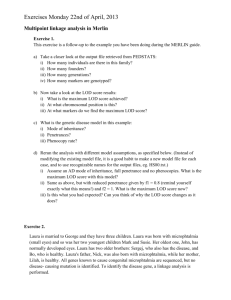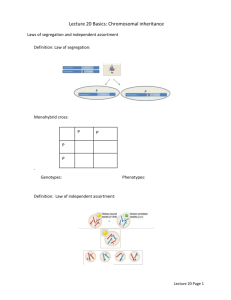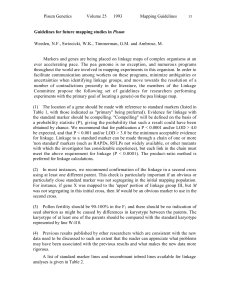18. Gene mapping
advertisement
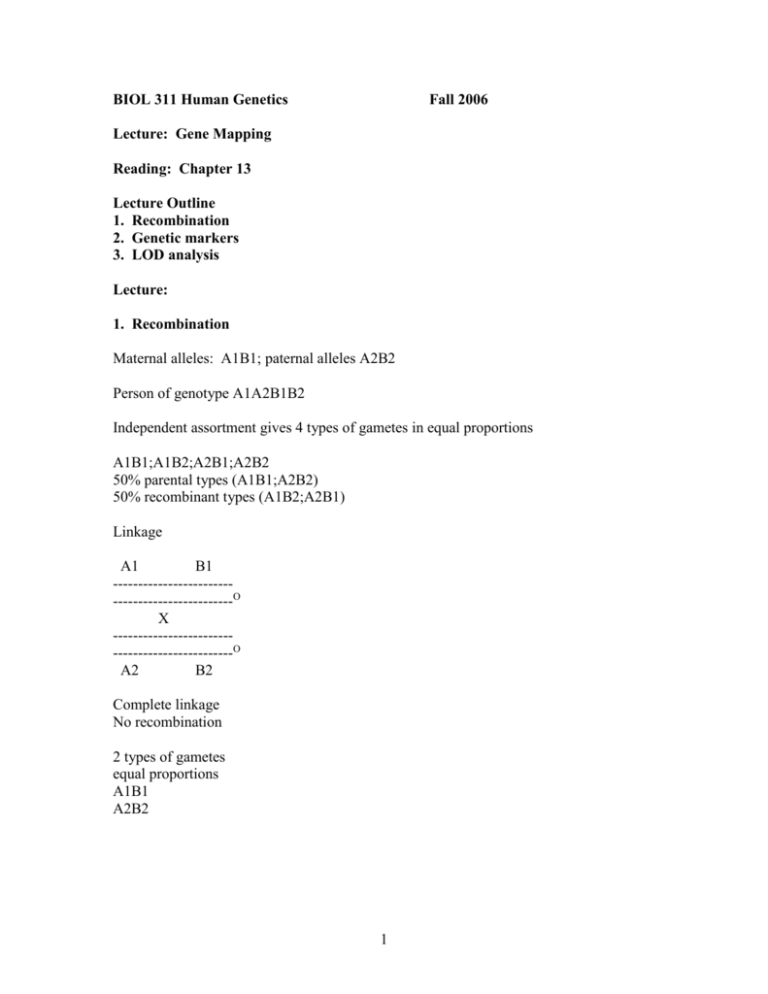
BIOL 311 Human Genetics Fall 2006 Lecture: Gene Mapping Reading: Chapter 13 Lecture Outline 1. Recombination 2. Genetic markers 3. LOD analysis Lecture: 1. Recombination Maternal alleles: A1B1; paternal alleles A2B2 Person of genotype A1A2B1B2 Independent assortment gives 4 types of gametes in equal proportions A1B1;A1B2;A2B1;A2B2 50% parental types (A1B1;A2B2) 50% recombinant types (A1B2;A2B1) Linkage A1 B1 -----------------------------------------------O X -----------------------------------------------O A2 B2 Complete linkage No recombination 2 types of gametes equal proportions A1B1 A2B2 1 Partial linkage Some recombination Mainly parental gametes A1B1;A2B2 Some recombinants A1B2;A2B1 Fig. 13-1 Identifying recombinants and non-recombinants in a pedigree Genetic distance is proportional to recombination frequency 1 cM=1 centimorgan=1 map unit=1% recombination frequency= # recombinants/total x 100 Parental frequencies > 50% Recombination frequencies < 50% Multiple crossovers often restore a parental arrangement of chromosomes, therefore the calculated recombination frequency often underestimates actual genetic distance. To correct for multiple crossovers, apply a statistical correlation called a "mapping function". The genetic map is not the same for males and females of the same species and varies along the length of the chromosome. Fig. 13-4. 2. Genetic markers Marker=any polymorphic Mendelian character that can be used to follow a chromosomal segment through a pedigree. Need markers as landmarks on chromosomes. Disease genes can be placed on map relative to markers. In 1998, 10,000 microsatellite markers were placed on framework maps of the human genome. For linkage analysis, need informative meioses--where you can tell whether progeny are recombinant or non-recombinant. Box 13-2 -------A1 marker-----------Disease gene---------- 2 If A1 is transmitted, disease gene is transmitted, except for recombinants when marker is separated from disease gene. Examples of uninformative and informative pedigrees A1A1 x A2A2 | A1A2 A1A2 x A1A2 | A1A2 A1A2 x A1A2 | A1A1 A1A2 x A3A4 | A2A4 Uninformative uninformative informative Non-recomb. Marker A1 not Ass. With disease informative Recombinant A1 not ass with disease Types of DNA markers RFLP: Restriction fragment length polymorphism Involves gain or loss of restriction site Not very informative Only two alleles Microsatellites (CA)n repeats Trinucleotide repeats Tetranucleotide repeats PCR amplify region around repeat Multiplex: multiple sets of primers to amplify many different microsatellites at once Multiple fluorescent tags SNPs Single nucleotide polymorphisms Two alleles Include RFLPs and nt sequence variation Allow high throughput Can be found anywhere in genome Microsatellites too far apart to score entire genome 3. LOD analysis logarithm of the odds humans have small families meioses are often not informative (see Fig. 13.6) use probability theory to estimate recombination frequency even when there is ambiguity in the pedigree. 3 Odds of linkage = genes are linked θ/genes are unlinked 0.5 0.5 represents 50% recombination LOD=logarithm of the odds Advantage can include uncertain results LOD scores can be added up across families to improve significance Box 13.3 Calculation of LOD scores If genes are linked, RF =θ Likelihood of a meiosis being recombinant=θ Likelihood of a meiosis being non-recombinant = 1=θ If genes are unlinked, the likelihood of a meiosis being either recombinant or nonrecombinant = 1/2 Family A Fig. 13-6 Informative--can calculate RF Calculated recombination frequency = 1/6 x 100 = 16.6% Overall likelihood given linkage is (1-θ)5 x θ First term is probability of non-recombinant and second is probability of recombinant Likelihood, no linkage (1/2)6 product of probability for no linkage for all six The likelihood ratio=(1-θ)5 x θ/(1/2)6 For each θ, calculate the log of the ratio (Z) θ Z 0 -infinity 0.1 0.577 0.2 0.623 0.3 0.509 0.4 0.299 0.5 0 More importantly, LOD scores can be calculated for families with ambiguity, although the calculations are cumbersome, so computer software is used. Interpretation of LOD score curves Fig. 13.7 + LOD: evidence for linkage 4 -LOD: evidence against linkage only recombination fractions between 0 and 0.5 are meaningful. All LOD scores are 0 at θ=0.5 Most likely recombination fraction is one where LOD score is the highest Fig. 13.7 Curve 1 Curve 2 no recombinants RF=0 RF ~0.23 If LOD score Z is greater or equal to 3, then genes are linked If LOD score S is less than -20, then genes are unlinked. Can be useful in telling where a disease gene is NOT located. If LOD score is between -2 and +3, linkage status is inconclusive 3 factor linkage useful for establishing gene order mapping of multiple markers at once helps overcome problem of non-informative meiosis High resolution mapping Autozygosity mapping--homozygosity for markers identical by descent, inherited from a recent common ancestor. Especially useful for inbred families with a genetic disease Most likely the disease gene is transferred with a bunch of neighboring markers Examine a person's "haplotype", transmission of a cluster of neighboring markers in vicinity of disease gene. Fig. 13-9 Autozygosity mapping in inbred family with autosomal recessive deafness. 5

